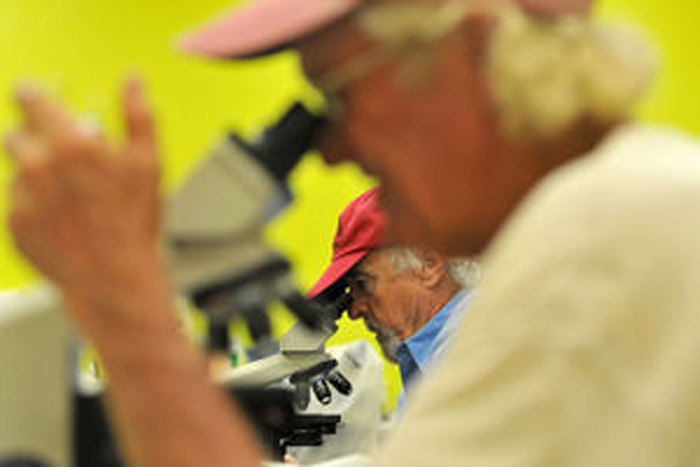“The fact is, it’s coming right down the coast,” Barry Goldsmith, warning coordination meteorologist for the National Weather Service in Brownsville, said yesterday. “If it’s already bad, it’s going to get worse.”
Dead fish washed onto the shore from the Island’s Beach Access No. 5 to the Port Mansfield Cut, said Tony Reisinger, Texas AgriLife’s extension agent for coastal and marine resources with Texas Sea Grant.
“Deteriorating conditions — obviously it’s moved south,” Reisinger said as he tested water samples on the Island.
Reisinger described the aerosol as light to moderate along the beach.
“The aerosol is everywhere,” he said.
“The aerosol varies. We’re coughing a lot.”
Water samples at Beach Access No. 6 revealed high concentrations of red tide, while a sample at Isla Blanca Park’s Brazos Santiago Pass channel showed low concentrations, Reisinger said.
On the Laguna Madre, he said, a sample on the west side of the Queen Isabella Memorial Causeway revealed moderate concentrations of the algae bloom.
Discoloration appeared in waters off the Island’s Beach Access No. 6.
In Port Mansfield, officials spotted no signs of red tide in the Laguna Madre, said Jessica Simmons, the Chamber of Commerce’s office manager.
Simmons said anglers continued to call to check local conditions.
“People are concerned about coming here. But they’re coming,” Simmons said. “They want an update. We aren’t seeing anything — not in the harbor, not in the bay.”
Forecasts of higher aerosol levels led the Texas General Land Office to cancel Saturday’s annual Adopt-A-Beach Fall Cleanup along South Padre Island.
“If I was making the forecast, it’d be for high concentrations during the weekend,” Goldsmith said. “It’s not going to be a good beach weekend.”
Yesterday, the aerosol left some visitors with itchy eyes and irritated throats.
Red tide, with the scientific name of Karenia Brevis, is an algal bloom caused by a species of dinoflagellets. The bloom can appear as a red or brown color.
Red tide’s effects include sneezing, watery and itchy eyes, coughing, runny nose, wheezing and shortness of breath.
People who suffer chronic respiratory problems like asthma should avoid red tide areas. For most people, symptoms are temporary. Wearing a particle filter mask may lessen effects while over-the-counter antihistamines may decrease symptoms. People who suffer persistent symptoms should seek medical attention.
Red tide also affects animals, acting as a neurotoxin that affects the central nervous system, causing paralysis. In fish, it enters through the gills and accumulates in organs.
Red tide is known to develop in the area between August and October, said Goldsmith.
Goldsmith said the Island area’s last serious outbreak occurred between September and November 2011.
In early November 2011, a cold front dropped temperatures into the 70s to clear the algae bloom, he said.
Reisinger said researchers have traced the origins of the area’s red tide to Mexico’s Bay of Campeche.
The algae bloom that threatens the area formed along the mid Texas coast and Coastal Bend, Goldsmith said.
More about:
















































